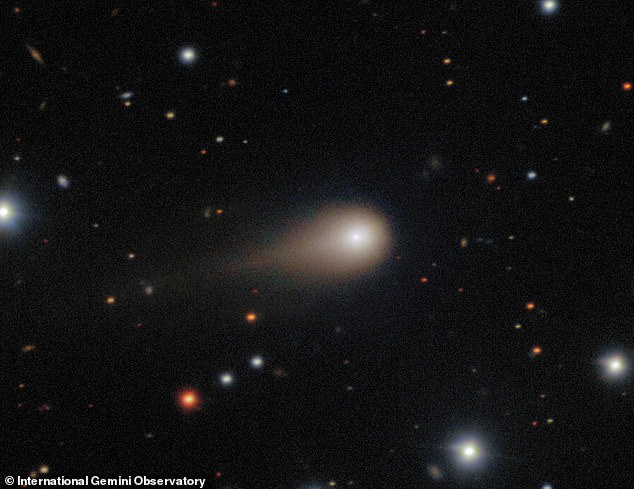The mysterious interstellar visitor streaking through our Solar System is just days away from revealing its true origins.
Harvard professor Avi Loeb told DailyMail.com that if the object, dubbed 3I/ATLAS, is a comet, it should ‘disintegrate into fragments’ as it swings closest to the sun on October 29, 2025.
The European Space Agency’s Jupiter probe will have a front-row seat, capturing the moment it either breaks apart or, as Loeb speculated, ‘releases mini-probes as a technological mothership.’
‘When a comet gets close to the sun, solar radiation heats its icy nucleus,’ Loeb explained.
‘Volatile ices like carbon dioxide, carbon monoxide, or water sublimate directly into gas, carrying away dust and small rocks.
‘This process can cause the comet to break apart if the mix of ice and dust cannot withstand the thermal stress.’
But if it does not, Loeb said, it could release ‘a fleet of mini-probes to study multiple targets simultaneously.’
Loeb noted there is a 30 to 40 percent chance the object ‘does not have a fully natural origin,’ noting the possibility it is a ‘Trojan Horse,’ where a technological object masquerades as a comet.

Harvard professor Avi Loeb told DailyMail.com that if the object, dubbed 3I/ATLAS, is a comet, it should ‘disintegrate into fragments’ as it swings closest to the sun on October 29, 2025
The ESA’s Jupiter Icy Moons Explorer (Juice) craft will have a view of the object when it comes 125 million miles from the planet and monitor it through November.
‘During November and December, terrestrial observatories will also be able to monitor 3I/ATLAS and check whether it disintegrated like a natural comet or released mini-probes as a technological mothership,’ Loeb explained.
While the professor believes there is a possibility it is of alien origin, NASA has long said the object is a natural comet.
The American space agency released images of 3I/ATLAS as it soared past Mars on October 3, showing it as cylindrical-shaped.
Stargazers on social media shared color-enhanced images of the object, which showed the interstellar visitor having a green glow.
Loeb and many other scientists are anticipating the visitor’s journey to the sun as it will finally put the mystery to rest.
3I/ATLAS will appear as a fuzzy ball of light in the blackness of space, and if it does disintegrate, the professor said it will break into independent, smaller dots of light.
‘Comets disintegrate primarily as a result of heating by the sun, but sometimes also by gravitational tides and rotational stress from outgassing,’ Loeb explained.

NASA released images of 3I/ATLAS as it soared past Mars on October 3, showing it as cylindrical-shaped. Stargazers on social media shared color-enhanced images of the object, which showed the interstellar visitor having a green glow
‘The catastrophic breakup of a comet into multiple fragments is difficult to forecast without knowing its detailed composition and material strength.’
So far, ESA’s Mars orbiters have not spotted any verified fragments, only faint artifacts and noise, as 3I/ATLAS moves closer to the sun.
Some reports have claimed that mysterious objects have been spotted with 3I/ATLAS, but Loeb told Daily Mail that these are false.
‘There are unrelated contemporary comets, background stars and images of the moons of Mars, Phobos and Deimos, which appear in some images. But so far, no verified object branched off 3I/ATLAS,’ the professor explained.
The object was first identified in July 2025 by the ATLAS telescope network, which looks for objects that might hit Earth.
Earlier images taken by the Vera C Rubin Observatory in Chile this summer had unknowingly photographed the object as well, but no one realized it was there at the time.
This article was originally published by a www.dailymail.co.uk . Read the Original article here. .

